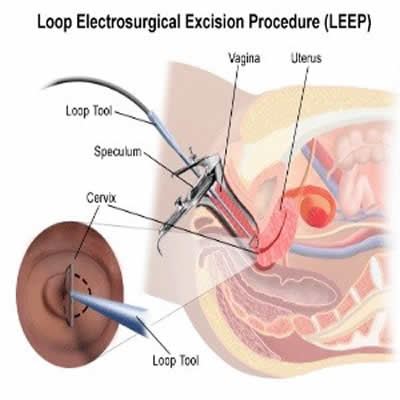What Is a LEEP Procedure? 
LEEP is a procedure to treat abnormal cells, also called dysplasia, on your cervix.
Cells on your cervix are constantly growing and changing. Sometimes these cells grow and change abnormally. These abnormal cells are usually first noticed on a Pap test. Once your Pap test or cervical biopsies have come back showing dysplasia, a LEEP may be recommended as treatment for these cells.
Dysplasia is not cancer, but can lead to cervical cancer if not treated. During a LEEP, your doctor can remove the affected tissue, including the transformation zone where abnormal cells develop. The specimen is sent to a pathologist to be sure that the dysplastic cells have been completely removed and that there is not cancer.
About 95% of patients are cured of their problem following a LEEP.
What Happens During a LEEP Procedure?
It is best to schedule a LEEP during the first half of the menstrual cycle, after you have stopped bleeding. The procedure begins like a Pap test. You will put your feet in stirrups and a speculum will be inserted into your vagina and opened. Now your doctor can see the cervix. Your cervix will be numbed with a local anesthetic. A mild vinegar solution, called acetic acid, will be applied to your cervix. This solution turns the affected cells white. Your doctor will place a colposcope, a binocular-like instrument outside your vagina to look at your cervix microscopically.
A fine wire loop is used to remove the abnormal tissue from your cervix. The loop will cut and seal blood vessels, decreasing bleeding. To further decrease bleeding, a medicated paste or solution may be applied to your cervix. This solution often causes a dark coffee-ground like vaginal discharge for a few days after the procedure. The tissue removed will be sent to a pathologist for diagnosis.
What Precautions Should I Take Following a LEEP?
Following the procedure, you may feel a few mild cramps and you will have a vaginal discharge. You should not put anything in your vagina, such as tampons, or have sexual intercourse for three to four weeks after your procedure. You should also avoid heavy lifting and vigorous exercise for three to four weeks.
Your doctor will want to monitor your Pap test more frequently for at least two years following your LEEP. To catch any problems early, it is very important that you see your doctor.
Call Your Doctor if You Notice:
- Heavy bleeding or bleeding with clots (a “coffee ground” discharge is normal)
- Severe abdominal pain
- Fever
- Foul-smelling discharge